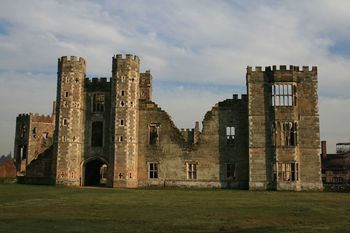Cowdray House
Cowdray House in Sussex is a 16th-century Tudor mansion which was badly damaged by fire in 1793. Construction began in the 1520s after Sir David Owen demolished a 13th-century manor house on the site and was completed by William Fitzwilliam in 1542. The ruins have been open to the public since the early 20th century.
History
The Bohun family owned Coudreye, and in 1273 Sir John Bohun began building a manor house there. The estates descended with the family until the late 15th century. When the Bohun line became extinct in the late 1490s Sir David Owen inherited the family property through his marriage to the daughter of the last John Bohun. [1] Beginning in around 1520, Owen set about demolishing the 13th-century manor house at Coudreye and building a grand house for himself. Owen did not live to see Cowdray completed, and died in 1535.[2]
Cowdray House was sold to Sir William Fitzwilliam in 1528 for £2,193 6s 8d. In the 1520s Fitzwilliam was rising to prominence, becoming a Justice of the Peace in Kent and Middlesex and by the time of his death had acquired 16,000 acres across three counties with an annual income of over £1,000.[3] By the late 1520s parts of the house were habitable as Owen was permitted to spend his remaining years there and Fitzwilliam moved in on the previous owner's death. The building work was finished under Fitzwilliam. After his death in 1542, Cowdray House and its lands passed to his half-brother, Sir Anthony Browne.[4] Four years earlier King Henry VIII had given Battle Abbey, also in Sussex, to Brown.[5] Possession of the house passed through Browne's descendants until the building was ravaged by fire in the 18th century.[4]
In 1533 Henry VIII granted representatives of Fitzwilliam a licence to crenellate Cowdray House. The licence allowed the holder to “impark 600 acres of land meadow, pasture and wood, in Essborne and Midhurst, Sussex, to be called the park of Cowdry, to have free warren and fishery within the same, and to build fortifications therein”.[6] Despite the wording of the licence, Cowdray House was not built as a fortification. While it features architectural elements found in castles – such as battlements around the tops of walls, though often without a walkway behind them.[7]
In 1793 George Samuel Browne, 8th Viscount Montague, was betrothed and Cowdray House was preparing for the marriage. While the Viscount was abroad in Switzerland a fire broke out. The small number of servants at the house on the night of 24th September were unable to extinguished the fire, which had begun in the north gallery but quickly spread. Only the kitchen escaped the fire because its thick walls prevented it spreading. A few days after the fire Browne drowned in the River Rhine. The Viscount had no brothers and left no male heir, so his title passed to a distant relative in France who also died without heirs. The family estates however passed to Browne's sister. In 1843 her daughters sold Cowdray House to the Earl of Egmont.[8]
References
- ↑ Howard, Bridget (2009). Cowdray. Midhurst: Cowdray Heritage Trust. p. 27. ISBN 978-0-85101-428-9.
- ↑ Woodburn, Bill and Guy, Neil (2005–6). "Cowdray House", Castle Studies Group Journal vol 19. p. 32.
- ↑ William B. Robison, ‘Fitzwilliam, William, earl of Southampton (c.1490–1542)’, Oxford Dictionary of National Biography, Oxford University Press, 2004; online edn, Jan 2008 accessed 26 Jan 2013
- ↑ 4.0 4.1 Woodburn & Guy, "Cowdray House", pp. 32–33.
- ↑ Coad, Jonathan (2007). Battle Abbey and Battlefield. London: English Heritage. pp. 41–42. ISBN 978-1-905624-20-1.
- ↑ Davis, Philip, “Cowdray House licence to crenellate”, Gatehouse Gazetteer, accessed 30 January 2013.
- ↑ Woodburn & Guy, “Cowdray House”, p. 45.
- ↑ Howard, Cowdray, p. 38.
